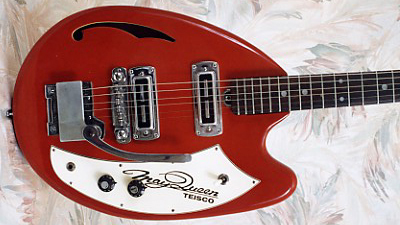


All copyrights are by the author and Vintage Guitar magazine. This article originally appeared in VG ‘s July ’03 issue. From the Teisco/ Silvertone site: The 1418 was one of the first guitars to hit the beach in preparation of the Fall 1968 Japanese Invasion of the.

In any case, these guitars represent a brief window of time that yielded some of the most fascinating and desirable guitars in a unique Japanese style. Its a ES-335 style guitar with a vibrato arm. How many of these exotic guitars were made is unknown, but we do know production was down dramatically by ’68 and models such as the May Queen seem to be pretty rare. Silvertone Guitar with case.This is a Silvertone guitar Model number9 circa 1968, and made by Teisco in Japan. Most carried metal Teisco del Rey logo plates, though, despite appearances, it’s not certain if this example was ever branded. high time I talked a little about Teisco and why a lot of people think every Japanese guitar is a Teisco. Most May Queens were produced in black, but occasionally unusual finishes such as this red one show up. 1968 Del Rey Electric Guitar Drowning in. Like most ’60s Japanese pickups, these large single-coil units are somewhat microphonic, but otherwise have a nice beefy output. The Teisco May Queen was a hollowbody guitar with a single catseye soundhole and a bolt-on neck with the “check-mark” headstock typical of the time. These guitars rank among the most aesthetically interesting creations of the ’60s… maybe of any time. Guyatone, Yamaha, Teisco and Kawai all introduced guitars ranging from highly distorted monsters such as the Sharp 5, the SG-3C “earlobe” and the exaggerated Vegas, to the more conservative (yet original) “artist palette” shape of this May Queen. Whether the whimsical guitars that appeared in ’68 were a desperate response to the drop in demand or a cavalier instance of Japanese guitarmakers flexing their muscles is unknown, but all of a sudden, exotic instruments had arrived. By ’68, the guitar industry was in trouble, both here (Valco/Kay went bust) and in Japan. In around 1964, another Chicago company, Weiss Musical Instruments (W.M.I.), founded by Sil Weindling, Barry Hornstein, and a former Westheimer employee Sid Weiss, took over importing Teiscos.Īccording to contemporary records, the ’60s guitar boom actually peaked in 1966. It was Jack Westheimer who added the “del Rey” portion to the brand name found on many guitars. Teisco guitars began to fuel the American “guitar boom” beginning in 1959 or ’60, when the Westheimer Sales Company in Chicago started importing them. In January of 1967, Teisco was purchased by the Kawai company, although, except for some convergences in style, Teisco production seems to have remained independent. Through the 1950s, most Teisco guitars were based on Gibson-style themes, though the ’60s saw a decided Fender influence emerge. Teisco guitars were born in Tokyo in 1946 when the company was founded by the famous Hawaiian and Spanish guitarist Atswo Kaneko and electrical engineer Doryu Matsuda. However, it doesn’t take much subtlety of vision to see the essential Japanese character of the guitars that burst on the scene in 1968, including this perennial classic, the Teisco May Queen. Initial pre-orders will include a hardshell case.While many Japanese guitars from the 1960s took their inspiration from American and European models, to the observant eye, there’s a strong undercurrent of Japanese design evident in many of these instruments. Get premium, high resolution news photos at Getty Images. The company produced guitars as well as synthesizers, microphones, guitar amplifiers and even drum kits.Teisco products were widely exported to the United States and the United Kingdom. This replica of the 1968 Teisco May Queen captures the original design features - hollowbody guitar shaped like an artist’s palette with a catseye soundhole - but upgrades the tremolo system and pickups. Studio still life of a 1968 Teisco Del Rey May Queen guitar, photographed in the United Kingdom. Teisco was a Japanese musical instrument manufacturing company from 1948 until 1967, when the brand 'Teisco' was acquired by Kawai ( Kawai Gakki Seisakusho). I have a small local dealer I have worked with for years who contacted Eastwood special for me to help me out. I have a Vox Mini XII (aka Mandoguitar) and this has the exact same shape. teisco et 200 electric guitar teisco et 200 tulip teisco del ray teisco del ray guitar 1960s teisco del rey. Eastwood made this replica last year as a one-time run. As such a lot of the local guitar manufacturers were making surf-style guitars, such as this quirky character. Back in 1960s Japan, The Ventures were absolutely unbeatable at least as big as The Beatles. I have wanted this guitar since I first saw the original, but forgot about it until it was in a blog post about cool/strange guitars. Teisco V-2, made in Japan 1968 approx, sunburst.


 0 kommentar(er)
0 kommentar(er)
